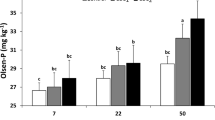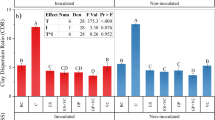Abstract
Gypsum and sulfur have been used as amendments for application in sodic and saline sodic soils, although gypsum is not effective in soil pH reduction. In this study the combined effects of elemental sulfur inoculated with Acidithiobacillus (S*) and gypsum (G) in chemical attributes of a Brazilian solodic soil was evaluated. The treatments consisted in addition of S* and G in various levels (0, 0.8, 1.6, 2.4, and 3.2 t ha−1) and different mixing proportions (100:0, 75:25, 50:50, 25:75, and 100:0), acting during 15, 30, and 45 days. Sulfur inoculated with Acidithiobacillus (S*) markedly reduced soil pH in the leaching solution, especially when applied in the highest levels. Gypsum or sulfur applied individually was not satisfactory for soil reclamation. At 15 days of incubation Na+, Ca2+, and Mg2+ showed higher values in the leaching solution, and a marked decrease was observed in the leaching solution at 30 days. Reduction in soil electrical conductivity and in exchangeable Na+, Ca2+, and Mg2+ was observed and in a general way best results were achieved with S* : G in the ratio 50:50, using 2.4 and 3.2 t ha−1. Sulfur with Acidithiobacillus was more effective than gypsum in decreasing soil pH, and sulfur applied with gypsum in the proportion 50:50 showed the best results in relation to exchangeable sodium and electrical conductivity and showed values below those used for classification as sodic soils.





Similar content being viewed by others
References
Armstrong ASB, Tanton TW (1992) Gypsum applications to aggregated saline-sodic clay topsoils. J Soil Sci 43:249–260
Ayars JG, Hutmacher RB, Schoneman RA, Vait SS, Pflaum T (1993) Long term use of saline water for irrigation. Irrigation Sci 14:27–34
Bajwa MS, Josan AS, Choodhary OP (1993) Effect of frequency of sodic and saline-sodic irrigations and gypsum on the build-up of sodium in soil and crop yields. Irrigation Sci 14:21–26
Barros MFC, Magalhães AM (1989) Avaliação de métodos de determinação da necessidade de gesso em solos salino-sódicos. Rev Bras Ciência do Solo 13:119–123
El-Tarabily KA, Soaud AA, Saleh ME, Matsumoto S (2006) Isolation and characterization of sulfur-oxidizing bacteria, including strains of Rhizobium from calcareous sandy soils and their effects on nutrient uptake and growth of maize (Zea mays L.). Aust J Agric Res 57:101–111
Embrapa—Empresa Brasileira de Pesquisa Agropecuária (1997) Manual de Métodos de Análises de Solos. Rio de Janeiro, p 212
Embrapa—Empresa Brasileira de Pesquisa Agropecuária (1999) Sistema Brasileiro de Classificação de Solos. Rio de Janeiro, p 412
Ferreira PA (1997) Aspectos físico-químicos do solo. In: Manejo e controle da salinidade na agricultura irrigada. In: Congresso Brasileiro de Engenharia Agricola, Campina Grande 1997. Anais..., Campina Grande: pp 36–67
Garcia O Jr (1992) O enxofre e suas transformações microbianas. In: Cardoso EJB, Tsai SM, Neves MCP (eds) Microbiologia do solo. Sociedade Brasileira de Ciência do Solo, Campinas, pp 1–15
Garcia O Jr (1991) Isolation and characterization of Thiobacillus thiooxidans and Thiobacillus ferrooxidans from mineral mines. Rev Bras Microbiol 20:1–5
Ghassemi F, Jakeman AJ, Nix HA (1995) Salinization of land and water resources: humans causes, extent, management and case studies. Center for Resources and Environment Studies, Canberra, p 526
Gupta RK, Abrol IP (1990) Salt–affected soil: then reclamation and management for crop production. Adv Soil Sci 11:223–228
Heyi HR, Azevedo NC, Batista MA, Santos JGR (1995) Comparação de métodos na recuperação de arroz em solo sódico. Rev Bras Ciência do Solo 19:173–178
Holanda JS, Vitti GC, Salviano AAC, Medeiros JDF, Amorim JRA (2000) Alterações nas propriedades de um solo aluvial salino-sódico decorrentes da subsolagem e do uso de condicionadores. Rev Bras Ciência do Solo 22:387–394
Myiamoto S, Enriquez C (1990) Comparative effects of chemical amendments on salt and Na leaching. Irrigation Sci 11:83–92
Miyamoto S, Riley T, Gobran G, Petticlew J (1986) Effects of saline water irrigation on soil salinity, pecan tree growth and nut production. Irrigation Sci 7:83–95
Moolman JH (1989) The effect of a change in irrigation water quality on the salt load of the deep percolate of a saline sodic soil- A computer simulation study. Irrigation Sci 6:19–28
Pereira JR, Valdivieso GR, Cordeiro GG (1986) Recuperação de solos afetados por sódio através do uso de gesso. In: Seminário sobre o uso de fosfogesso na agricultura. 1. 1985. Embrapa/DDT, Brasília, Anais..., Brasília, pp 85–105
Richards LA (1954) Diagnosis and improvement of saline and alkali soils. US Department of Agriculture Handbook 60. US Government Printing Office, Washington
Rowell DL (1985) The reduction in sodicity during the displacement of mixed CaCl2—NaCl salts from soils by water. Irrigation Sci 6:1–18
Stamford NP, Freitas ADS, Ferraz DS, Santos CERS (2002) Effect of sulfur inoculated with Thiobacillus on saline soils amendment and growth of cowpea and yam bean legumes. J Agric Sci 139:275–281
Stamford NP, Freitas ADS, Ferraz DS, Montenegro A, Santos CERS (2003) Nitrogen fixation and growth of cowpea and yam bean legumes in a sodic soil as affected by gypsum and sulfur inoculated with Thiobacillus and rhizobial inoculation. Trop Grasslands 38:1–7
Stamford NP, Moura AMMF, Santos KSR, Santos PR (2004) Atuação de Acidithiobacillus na solubilização de fosfato natural em solo de tabuleiro cultivado com jacatupé (Pachyrhizus erosus). Rev Bras Ciência do Solo 28:75–83
Stamford NP, Santos CERS, Santos PR, Santos KS, Montenegro A (2005) Effects of rock phosphate, sulfur with and without Acidithiobacillus and organic by-products on mimosa (Mimosa caesalpiniifolia) grown in a Brazilian tableland soil. Trop Grasslands 39:54–61
Acknowledgements
This work was supported by CNPq (Conselho Nacional de Desenvolvimento Científico e Tecnológico, Brasil) and FACEPE (Fundação de Apoio a Ciência e Tecnologia do Estado de Pernambuco, Brasil), and also we would like to acknowledge CNPq to the fellowships.
Author information
Authors and Affiliations
Corresponding author
Rights and permissions
About this article
Cite this article
Stamford, N.P., Ribeiro, M.R., Cunha, K.P.V. et al. Effectiveness of sulfur with Acidithiobacillus and gypsum in chemical attributes of a Brazilian sodic soil. World J Microbiol Biotechnol 23, 1433–1439 (2007). https://doi.org/10.1007/s11274-007-9387-6
Received:
Accepted:
Published:
Issue Date:
DOI: https://doi.org/10.1007/s11274-007-9387-6




